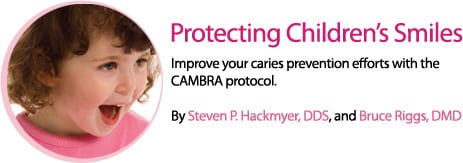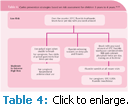
Protecting Children’s Smiles
Improve your caries prevention efforts with the CAMBRA protocol.
This course was published in the February 2012 issue and expires February 2015. The authors have no commercial conflicts of interest to disclose. This 2 credit hour self-study activity is electronically mediated.
EDUCATIONAL OBJECTIVES
After reading this course, the participant should be able to:
- Discuss the origins of caries management risk assessment (CAMBRA).
- Detail risk factors for caries development.
- List preventive and therapeutic strategies for caries management.
Caries management by risk assessment (CAMBRA) is an evidence-based protocol focused on preventing, reversing, and treating caries before the disease process causes irreversible damage to tooth structure.4 CAMBRA is unique because it focuses on the entire caries disease process instead of the progression of the carious lesion itself. The CAMBRA protocol treats caries as a highly infectious and transmittable bacterial disease that can be effectively treated and/or reversed.1 While traditional caries treatment has emphasized restorative care, CAMBRA focuses on prevention by identifying at-risk patients and implementing strategies to prevent or reduce caries development.
The Beginning
CAMBRA is based on Featherstone’s caries balance theory, and uses risk assessment to determine treatment decisions.5 At the time CAMBRA was developed, the science supporting it was not new, but implementing the protocol into clinical practice was stalled until the formation of the Western CAMBRA Coalition in 2002. Dental professionals from five California dental schools met informally to discuss how to improve caries management standards.4 The group branched out to create a consortium that included education, research, and clinical practice. Their efforts resulted in furthering the reach of CAMBRA through conferences, publication of journal articles, and public/private partnerships.4
Caries Risk Assessment
Today, caries risk assessment forms are easily accessed from the American Academy of Pediatric Dentistry (Tables 1 and 2), American Dental Association (ADA), and California Dental Association (Table 3). They provide a standardized format for assessing and documenting caries risk. Divided by age, the dental professional notes each patient’s risk factors on the form and then tallies the results, which categorize the patient as low, moderate, or high risk. Prevention and treatment plans are then implemented based on the designated category of risk.
The most important indicator of future caries risk is previous caries experience. This is key when treating children and adolescents, but has limitations when treating infants/toddlers.6 Risk factors are identified as biological (susceptible host, diet, microflora levels, and socioeconomic status) and clinical (plaque accumulation, white spot lesions, precavitated lesions, and caries).7-12 Additional factors include presence of orthodontic appliances, xerostomia (disease-related or medication induced), special health care needs, bottle or nursing habits, incipient lesions (both radiographic and clinical), and caries within the first 3 years.13-15
The evaluation of the bacterial levels present in saliva is an important factor in caries risk assessment.7 Saliva serves many functions, including lubrication of the mucosa and helping in mastication of food, swallowing, and even speech.16 Saliva also protects teeth by acting as a buffer and neutralizing the acids produced during the intake of various foods and beverages, thus aiding in the remineralization of the tooth surface.16 The presence of Streptococcus mutans in saliva and plaque—regardless of whether caries is present—is an indicator of risk.17 A number of commercially available kits are available that analyze the microflora present in a patient’s saliva.
Table 3. Resources for Caries Risk Assessment Forms
American Academy of Pediatric Dentistry
Click to access document
American Dental Association: For patients age 6 and younger:
Click to access document – 2011-10-25
For patients older than age 6:
Click to access document – 2011-10-25
California Dental Association
For patients age 5 and younger:
Click to access document
For patients older than age 5:
Click to access document
The frequency of food and liquid intake, especially snacks and sugary drinks, must be evaluated. The consumption of fermentable carbohydrates significantly contributes to the development of caries. Bacteria produce acids that feed on fermentable carbohydrates, leading to enamel breakdown.13
In order to promote better oral health, oral hygiene and overall self-care must also be assessed and appropriate instruction provided. The type of toothbrush, amount of fluoride-containing toothpaste used during brushing, frequency of brushing and flossing, use of irrigation devices, and fluoride supplements and rinses used should be addressed for each individual. Previous caries experience of patients, their caregivers (mainly mothers), and siblings must also be considered.13
Preventive Tools and Treatment
An aggressive preventive approach should become part of routine recare visits for all children—regardless of caries risk status—and may include saliva analysis, diet assessment, and patient/parent education. Table 4 provides a description of caries prevention strategies based on risk assessment for children aged 3 to 6.18-20 Diet analysis and recommendation tools are available through the United States Department of Agriculture’s website—www.choosemyplate.gov—which was up dated in 2011 and provides information both for consumers and professionals.21
Prevention-based office visits include professional prophylaxis, topical fluoride treatment, or fluoride varnish application.22,23 Pit and fissure sealants are also effective in caries prevention.24 Sealants can be placed on noncavitated primary and permanent posterior teeth or early noncavitated lesions on permanent posterior teeth.24 Detecting early minimal caries and placing a sealant over the lesion can inhibit bacteria growth and arrest the lesion’s progression. This is key in the quest to avoid restorative care.25,26
Preventive therapy for patients outside of the professional setting include the recommendation of gum, hard candies, or lozenges containing polyols, such as xylitol or sorbitol, for children older than 5 years. The gum should be chewed for at least 10 minutes following meals. To maximize benefits, a dose of 5 g to 8 g per day divided over two or three doses must be ingested.26 Patients at low to moderate risk of caries should use 0.05% over-the-counter fluoride rinses.
Research shows that while the use of chlorhexidine-containing products is effective in preventing root caries, they may not significantly reduce coronal caries so their implementation should be on a case-by-case basis.27 Fluoride supplementation in areas without community water fluoridation should be considered.28 For those at high risk of caries, prescription high-dose fluoride topical pastes or dentifrices for at-home use may be helpful.28 Adding products that contain calcium and phosphate technologies to the self-care routine may also help support caries prevention.1,20
Young patients may be more inclined to brush with a power toothbrush as opposed to a manual brush. Power toothbrushes may also allow for the deeper penetration of fluoride into interproximal biofilm, thereby increasing the tooth’s exposure to fluoride.29
Conclusion
Substantial evidence-based data demonstrate both CAMBRA’s efficacy and usefulness in the dental practice, yet many practices have yet to implement its protocols.13 Dental hygienists can be the leader in CAMBRA implementation. Hopefully, with their support, caries risk assessment will become a routine part of the pediatric dental practice and lead to significant improvements in the oral health of our nation’s youngest patients.
REFERENCES
- Featherstone, J. Dental caries: a dynamic disease process. Aust Dent J. 2008;53:286-291.
- Centers for Disease Control and Prevention. Hygiene-related Diseases: Dental Caries (Tooth Decay). Available at: www.cdc.gov/healthywater/hygiene/disease/dental_caries.html. Accessed January 13, 2012.
- Centers for Disease Control and Prevention. Oral Health Improving for Most Americans, But Tooth Decay Among Preschool Children on the Rise: Trends in Oral Health Status: United States, 1988-1994 and 1999-2004. Available at: www.cdc.gov/nchs/data/series/sr_11/sr11_248.pdf. Accessed January 18, 2012.
- Young DA, Buchanan PM, Lubman RG, Badway NN. New directions in interorganizational collaboration in dentistry: the CAMBRA Coalition model. J Dent Educ. 2007;71: 595-600.
- Featherstone JD. The science and practice of caries prevention. J Am Dent Assoc. 2000;131: 887-899.
- Zero D, Fontana M, Lennon AM. Clinical applications and outcomes of using indicators of risk in caries management. J Dent Educ. 2001;65: 1126-1132.
- Litt MD, Reisine S, Tinanoff N. Multidimensional causal model of dental caries development in low-income preschool children. Public Health Rep. 1995;110:607-617.
- Nicolau B, Marcenes W, Bartley M, Sheiham A. A life course approach to assessing causes of dental caries experience: the relationship between biological, behavioural, socio-economic and psychological conditions and caries in adolescents. Caries Res. 2003;37:319-326.
- Featherstone JD. The caries balance: The basis for caries management by risk assessment. Oral Health Prev Dent. 2004;2(Suppl):259-264.
- Vargas CM, Crall JJ, Schneider DA. Sociodemographic distribution of pediatric dental caries: NHANES III, 1988-1994. J Am Dent Assoc. 1998;129:1229-1238.
- Vadiakas G. Case definition, aetiology and risk assessment of early childhood caries (ECC): a revisited review. Eur Arch Paediatr Dent. 2008;9:114-125.
- Alaluusua S, Malmivirta R. Early plaque accumulation–a sign for caries risk in young children. Community Dent Oral Epidemiol. 1994;22:273-276.
- American Academy of Pediatric Dentistry. Guideline on Caries-risk Assessment and Management for Infants, Children, and Adolescents. Available at: www.aapd.org/media/Policies_Guidelines/G_CariesRiskAssessment.pdf. Accessed January 13, 2012.
- American Dental Association. Caries Risk Assessment Forms. Available at: www.ada.org/5157.aspx#resources. Accessed January 13, 2012.
- California Dental Association. Caries Risk Assessment Form. Available at: www.cdafoundation.org/who_we_are/publications/cda_journal_october_2007. Accessed January 13, 2012.
- Pedersen, A, Bardow, A, Jensen, SB, Nauntofte, B. Saliva and gastrointestinal functions of taste, mastication, swallowing and digestion. Oral Dis. 2002,8:117-129.
- Thenisch NL, Bachmann LM, Imfeld T, Leisebach M, Steurer J. Are mutans streptococci detected in preschool children a reliable predictive factor for dental caries risk? A systematic review. Caries Res. 2006;40:366-374.
- Jenson L, Budenz AW, Featherstone JD, Ramos-Gomez FJ, Spolsky VW, Young DA. Clinical protocols for caries management by risk assessment. J Calif Dent Assoc. 2007;35:714-723.
- Francisco E, Azevedo S, Young DA. Caries management for the whole family. Dimensions of Dental Hygiene. 2009;7(2):34-37.
- Ramos-Gomez F, Crystal YO, Ng MW, Tinanoff N, Featherstone JD. Caries risk assessment, prevention, and management in pediatric dental care. Gen Dent. 2010;58:505-517.
- United States Department of Agriculture. SuperTracker and Other Tools. Available at: www.choosemyplate.gov/supertracker-tools.html. Accessed January 13, 2012.
- American Dental Association Council on Scientific Affairs. Professionally applied topical fluoride: evidence-based clinical recommendations. J Am Dent Assoc. 2006;137:1151-1159.
- Rozier RG, Adair S, Graham F, et al. Evidence-based clinical recommendations on the prescription of dietary fluoride supplements for caries prevention: a report of the American Dental Association Council on Scientific Affairs. J Am Dent Assoc. 2010;141:1480-1489.
- Beauchamp J, Caufield PW, Crall JJ, et al. Evidence-based clinical recommendations for the use of pit-and-fissure sealants: a report of the American Dental Association Council on Scientific Affairs. J Am Dent Assoc. 2008;139:257-268.
- Griffin SO, Oong E, Kohn W, et al. The effectiveness of sealants in managing caries lesions. J Dent Res. 2008;87:169-174.
- Oong EM, Griffin SO, Kohn W, Gooch BF, Caufield PW. The effect of dental sealants on bacteria levels in caries lesions: a review of the evidence. J Am Dent Assoc. 2008;139:271-278.
- Rethman MP, Beltrán-Aguilar ED, Billings RJ, et al. Nonfluoride caries-preventive agents: executive summary of evidence-based clinical recommendations. J Am Dent Assoc. 2011;142: 1065-1071.
- American Academy of Pediatric Dentistry. Guideline on Fluoride Therapy. Available at: www.aapd.org/media/Policies_Guidelines/G_FluorideTherapy.pdf. Accessed January 13, 2012.
- Aspiras M, Stoodley P, Nistico L, Longwell M, de Jager, M. Clinical implications of power toothbrushing on fluoride delivery: effects on biofilm plaque metabolism and physiology. Int J Dent. 2010;2010:651869.
From Dimensions of Dental Hygiene. February 2012; 10(2): 54-56, 59.




